The 2025 classics season began with a shock when Søren Wærenskjold won Omloop Nieuwsblad. Over the next two months, there were a few more surprises, along with many expected winners. world champion Tadej Pogačar won Strade Bianche, the Tour of Flanders, La Flèche Wallonne, and Liège-Bastogne-Liège. And it was Mathieu Van der Poel who won Milan-San Remo, E3, and Paris-Roubaix.
Remco Evenepoel made his comeback at De Brabantse Pijl, winning the sprint against Wout van Aert, and that wasn’t the only surprising sprint of the classics season – Neilson Powless beat Van Aert and Visma Lease-a-bike at Dwars door Vlaanderen, while Mattias Skjelmose outsprinted Pogačar and Evenepoel at Amstel Gold Race.
In this article, we’re going to take a closer look at the most impactful storylines from the 2025 classics season. The world champion could be timing his Tour de France peak to perfection, or he could carry classics-induced fatigue throughout the rest of the season. Pogačar also crashed twice in key moments of the classics – could these falls affect the rest of his season?
Finally, we will examine the prospect of peak form and how long riders can maintain it. Some riders time it perfectly, while others peak at all the wrong times.
Pogačar Begins Racing at the UAE Tour
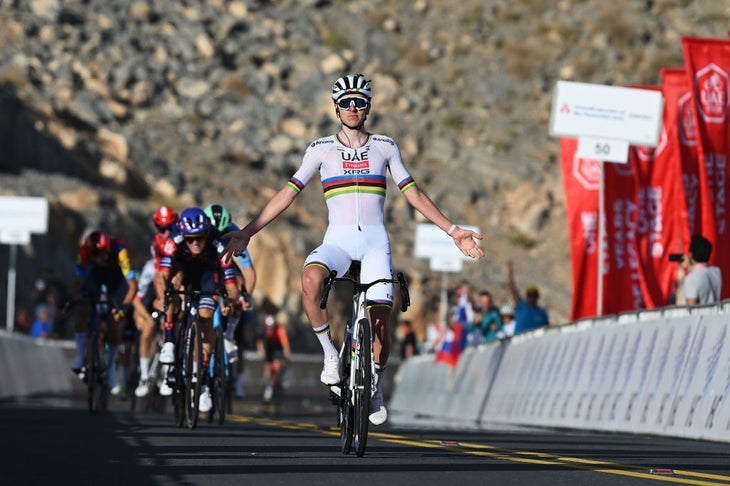
Tadej Pogačar’s 2025 campaign began nearly three months ago on February 17 at the first stage of the UAE Tour. You could say that it’s already been a long season for the world champion. However, he only has 14 race days since the start of the year. That leaves plenty of time for travel, rest, and training.
The UAE Team Emirates XRG rider won two stages and the GC at the UAE Tour, but the climbing times suggest that he was far from his best. In fact, Pogačar’s time on Jebel Hafeet was one of the slowest winning times in the last few years. Even when considering the headwind on the climb, Pogačar’s performance was nothing special compared to what he was doing in the Tour de France last year. So even though he was winning, Pogačar was still in training mode.
View this post on Instagram
Pogačar – Jebel Hafeet
- Time: 26:54
- Estimated Average Power: ~430w (6.7w/kg)
His form began to build in March when he won Strade Bianche. The Slovenian seemed to be in control of the race, but then he crashed on a high-speed descent (more on that in a minute). After he dusted off the rainbow jersey, Pogačar made his way back to the front and then dropped Tom Pidcock to take the win.
But again, the numbers suggest that Pogačar was not at his best. With all due respect, you have to look at the riders that Pogačar dropped with his attacks at Strade Bianche: Lennert Van Eetvelt, Magnus Cort, Ben Healy, Roger Adrià, etc. These are great riders, but they are not the same level of competition Pogačar would soon face in Mathieu van der Poel, Filippo Ganna, and Mads Pedersen.
While Pogačar’s form was building, Pidcock was smashing power PRs in Saudi Arabia, an ominous sign as the season had only just begun. The Brit won two stages and the GC at the AlUla Tour, then he won again at the Vuelta a Andalucia. After finishing second at Strade Bianche, Pidcock has failed to win since February 20. Perhaps Pidcock will return to winning ways soon, but it is clear that he peaked too early in this classics season.
The monuments begin with Milan-San Remo
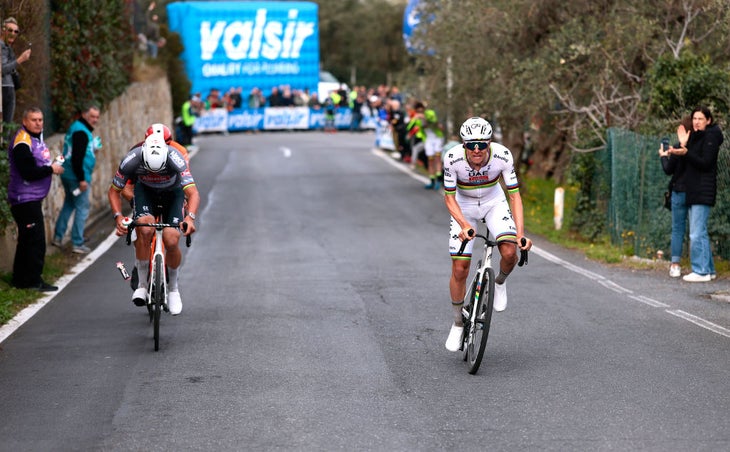
The first monument of the year was Milan-San Remo, and Pogačar was determined to win. After a ridiculous leadout from UAE Team Emirates-XRG, Pogačar set the climbing record on the Cipressa, dropping everyone but MVDP and Ganna. The trio kept splitting and reforming all the way to the finish, but it was Van der Poel who won the sprint ahead of Ganna and Pogačar. Again, the numbers suggest that Pogačar was improving, but he wasn’t yet at his best.

Pogačar – Cipressa
- Time: 8:59
- Estimated Average Power: ~487w (7.5w/kg)
Next up was the Tour of Flanders and Paris-Roubaix. In the former, we witnessed an incredible performance from Pogačar, who soloed to the win ahead of Pedersen and Van der Poel. The world champion set some more climbing records that day, showing that his form was continuing to improve week by week.
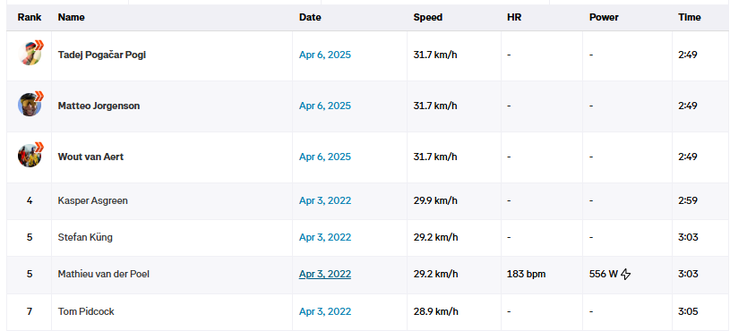
Pogačar – Attack on the Second Oude Kwaremont
- Time: 2:49
- Estimated Average Power: ~540w (8.3w/kg)
After months of anticipation, Pogačar confirmed his participation in Paris-Roubaix, delivering a performance that cycling fans had been waiting for. He attacked again and again, but then he overcooked a corner and tumbled into the grass. Van der Poel soloed to victory while Pogačar held on for second, with both riders showing their peak shape.
Another rider who has been able to peak at the right moments is Filippo Ganna. The Italian has balanced road racing, time trials, and track cycling for many years, earning multiple world championships across the disciplines. With so much racing year-round, it can be difficult to be in top shape for certain races. But Ganna seems to be a master at this.
The 28 year-old began the season anonymously at Etoile de Bessèges and Volta ao Algarve (where he would have won the first stage had the officials not annulled the result). After winning the time trial at Tirreno-Adriatico, Ganna wasn’t showing race-winning form. But when he turned up to Milan-San Remo a few weeks later, he was the only rider who could follow Pogačar and Van der Poel on the Cipressa.
Pogačar Shows Vulnerability in the Ardennes
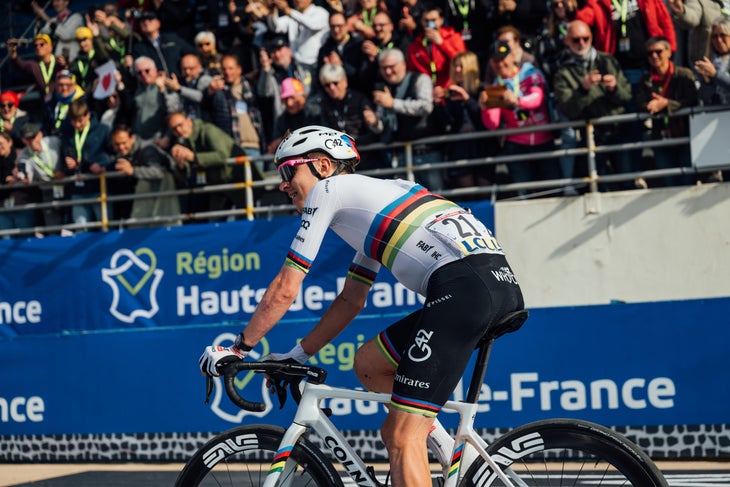
With 47.7 km to go, Tadej Pogačar attacked in the Amstel Gold Race. He soon went solo, and that was that…surely.
But then, the gap stabilized. The chasers were less than a minute behind Pogačar, and he wasn’t looking great. Inside 10 km to go, Evenepoel and Skjelmose made the catch, and it was the Dane who came out on top in the sprint. Had Pogačar peaked too early? Was the fatigue starting to catch up with him?
Those questions were put to rest when Pogačar dominated La Flèche Wallonne and Liège-Bastogne-Liège only a few days later. The world champion was doing his best numbers ever, and some of the best 3-5 minute w/kg numbers in the history of cycling. Pogačar dropped everyone with a seated attack on both the Mur de Huy and La Redoute. He made it look easy, but he was certainly working hard. He was in the form of his life.
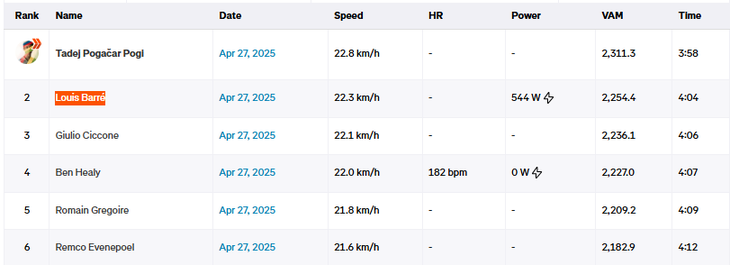
Pogačar – Fastest Time Ever on La Redoute
- Time: 3:58
- Estimated Average Power: ~550w (8.4w/kg)
Pogačar’s #1 Rival is Himself
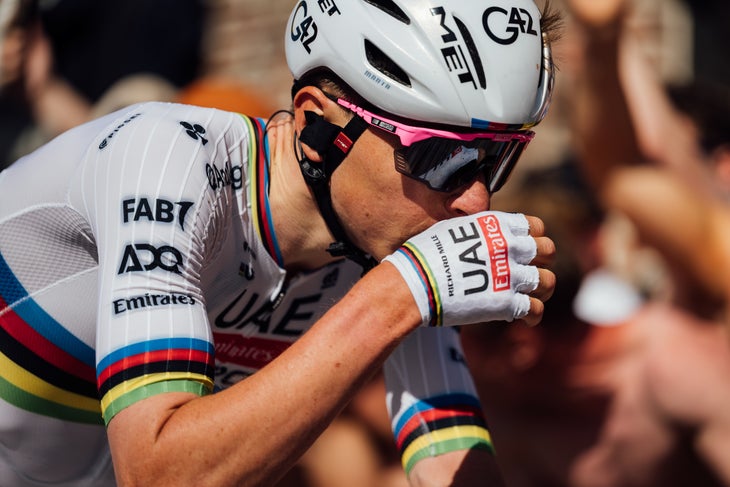
Outside of the Amstel Gold Race, Pogačar’s performances throughout the classics were nearly perfect. Few expected him to win his first Paris-Roubaix against Mathieu Van der Poel, and there wasn’t much more he could’ve done to win Milan-San Remo. However, there is one glaring flaw in Pogačar’s recent performances.
During key moments of important races, typically after he has just attacked, Pogačar has a heightened risk of crashing. The crashes seem to occur when Pogačar has just made a massive effort — his heart rate is near its max, the speed is very high, and his concentration might be on his legs rather than the road in front of him.
In Strade Bianche, Pogačar led into a left-hand corner and slid out at ~60 kph. The crash was entirely his fault — he was in the lead group of three, there were many kilometers to go, and master descender Pidcock had been in the lead. There was no need to push, yet Pogačar went over his limit and crashed hard.
A month later at Paris-Roubaix, a similar situation occurred where Pogačar attacked into a right-hand corner and crashed into the grass. Thankfully, this crash was much slower and softer because Pogačar had time to brake, but it was still a nail-biting scenario. The world champion was attempting to drop Van der Poel with this attack, but it was another worrying lapse of concentration that could’ve ended much worse.
View this post on Instagram
Power Analysis data courtesy of Strava
Strava sauce extension
Riders:
